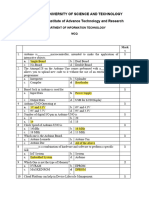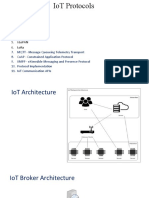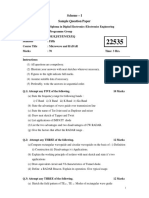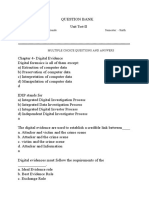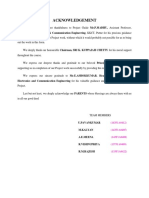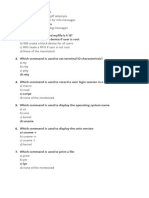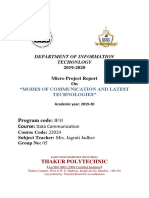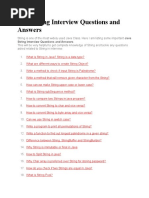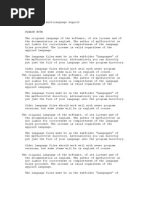Question Bank ETI
Question Bank ETI
Uploaded by
VaibhavCopyright:
Available Formats
Question Bank ETI
Question Bank ETI
Uploaded by
VaibhavCopyright
Available Formats
Share this document
Did you find this document useful?
Is this content inappropriate?
Copyright:
Available Formats
Question Bank ETI
Question Bank ETI
Uploaded by
VaibhavCopyright:
Available Formats
Question Bank
Sub-ETI
1) Which of these schools was not among the early leaders in AI research?
A. Dartmouth University B. Harvard University
C. Massachusetts Institute of Technology D. Stanford University
E. None of the above
2) DARPA, the agency that has funded a great deal of American AI research, is part of the
Department of:
A. Defense B. Energy C. Education D. Justice E. None of the above
3) The conference that launched the AI revolution in 1956 was held at:
A. Dartmouth B. Harvard C. New York D. Stanford E. None of the above
4) How many approaches are there in AI?
A) 1 B) 2 C) 3 D) 4
5) How many core components are there in AI?
A) 19 B) 12 C) 13 D) 10
6) Who is a father of AI?
A. Alain Colmerauer B. John McCarthy C. Nicklaus Wirth D. Seymour Papert
7) Artificial Intelligence has its expansion in the following application.
A. Planning and Scheduling B. Game Playing C. Robotics D. All of the above
8) The characteristics of the computer system capable of thinking, reasoning and learning is
Known is
A. machine intelligence B. human intelligence C. artificial intelligence D. virtual intelligence
9) In ____ the goal is for the software to use what it has learned in one area to solve problems in
Other areas.
A. Machine Learning B. Deep Learning C. Neural Networks D. None of these
10) Human to Machine is _____ and Machine to Machine is ______.
A. Process, Process B. Process, Program C. Program, Hardware D. Program, Program
11) Narrow AI is performs multiple task at a time.
A. True B. False
12) Strong AI is__________
A. The embodiment of human intellectual capabilities within a computer.
B. A set of computer programs that produce output that would be considered to reflect
Intelligence if it were generated by humans.
C. The study of mental faculties through the use of mental models implemented on a computer
D. the entire above E. None of the above
13) Which machines will be smarter than human mind?
A. Reactive machine B. Limited memory C. Theory of mind D. Self-Awareness
14) What is Machine learning?
A. The autonomous acquisition of knowledge through the use of computer programs
B. The autonomous acquisition of knowledge through the use of manual programs
C. The selective acquisition of knowledge through the use of computer programs
D. The selective acquisition of knowledge through the use of manual programs
15) Which of the following is true about CISC processors?
A. The instruction set is non-orthogonal
B. The number of general purpose registers is limited
C. Instructions are like macros in c language D. Variable length instructions
E. All of these F. None of these
16) Main processor chip in computers is_______
A. ASIC B. ASSP C. CPU D. CPLD
17) Which architecture is followed by general purpose microprocessors?
A. Harvard architecture B. Von Neumann architecture C. None of the mentioned
D. All of the mentioned
18) ARM processors where basically designed for _______
A. Main frame systems B. Distributed systems C. Mobile systems D. Super computers
19) ASIC stands for
A. Application-System Integrated Circuits B. Application-Specific Integrated Circuits
C. Application-System Internal Circuits D. Application-Specific Internal Circuits
20) Term "the Internet of things" was coined by
A. Edward L. Schneider B.Kevin Ashton C. John H. D. Charles Anthony
21) What does “Things” in IoT refers to?
A. General device B. Information C. IoT devices D. Object
22) _____________ is a computing concept that describes the idea of everyday physical objects
being connected to the internet.
A. IOT (Internet of Things) B. MQTT C. COAP D. SPI
23) Which one is not element of IOT?
A. Process B. People C. Security D. Things
24) The first AI programming language was called:
A. BASIC B. FORTRAN C. IPL D. LISP
25) Which architecture is followed by general purpose microprocessors?
A. Harvard architecture
B. Von Neumann architecture
C. None of the mentioned
D. All of the mentioned
26.What is Artificial intelligence?
a)Putting your intelligence into Computer b)Programming with your own intelligence
c) Making a Machine intelligent d)Playing a Game
27.Devices that transforms electrical signals into physical movements
a) Sensors b) Actuators c) Switches d) Display
28.The conference that launched the AI revolution in 1956 was held at:
A. Dartmouth B. Harvard C. New York D. Stanford E. None of the above
29.How many approaches are there in AI?
A) 1 B) 2 C) 3 D) 4
30.How many core components are there in AI?
A) 19 B) 12 C) 13 D) 10
31.What are the issues on which biological networks proves to be superior than AI networks?
a) robustness & fault tolerance b) flexibility c) collective computation
d) all of the mentioned
32.Artificial Intelligence has its expansion in the following application.
A. Planning and Scheduling B. Game Playing C. Robotics D. All of the above
33.The characteristics of the computer system capable of thinking, reasoning and learning is
Known is
A. machine intelligence B. human intelligence C. artificial intelligence D. virtual intelligence
34.A process that is repeated, evaluated, and refined is called:
a.diagnostic b.descriptive c.interpretive d.iterative
35.Human to Machine is _____ and Machine to Machine is ______.
A. Process, Process B. Process, Program C. Program, Hardware D. Program, Program
36.Narrow AI is performs multiple task at a time.
A. True B. False
37.Weak AI is
A. the embodiment of human intellectual capabilities within a computer.
B. a set of computer programs that produce output that would be considered to reflect
intelligence if it were generated by humans.
C. the study of mental faculties through the use of mental models implemented on a
computer.
D. All of the above
38.Ambiguity may be caused by:
A.syntactic ambiguity Multiple word meanings Unclear antecedents
D. All of the above
39.What is Machine learning?
A. The autonomous acquisition of knowledge through the use of computer programs
B. The autonomous acquisition of knowledge through the use of manual programs
C. The selective acquisition of knowledge through the use of computer programs
D. The selective acquisition of knowledge through the use of manual programs
40.Which of the following is true about CISC processors?
A. The instruction set is non-orthogonal
B. The number of general purpose registers is limited
C. Instructions are like macros in c language D. Variable length instructions
E. All of these F. None of these
41.Which one is not a element of IoT
a) People b) Process c) Security d) Things
42.Which of the following is not Application layer protocol for IoT
a) HTTP b) MQTT c) TCP d) COAP
43.ARM processors where basically designed for _______
A. Main frame systems B. Distributed systems C. Mobile systems D. Super computers
44.ASIC stands for
A. Application-System Integrated Circuits B. Application-Specific Integrated Circuits
C. Application-System Internal Circuits D. Application-Specific Internal Circuits
45.IoT stands for
a) Internet of Technology b) Intranet of Things c) Internet of Things
d) Information of Things
46.What does “Things” in IoT refers to?
A. General device B. Information C. IoT devices D. Object
47._____________ is a computing concept that describes the idea of everyday physical objects
being connected to the internet.
A. IOT (Internet of Things) B. MQTT C. COAP D. SPI
48.Which one is not element of IOT?
A. Process B. People C. Security D. Things
49.The first AI programming language was called:
A. BASIC B. FORTRAN C. IPL D. LISP
50.Devices that transforms electrical signals into physical movements
a) Sensors b) Actuators
c) Switches d) DisplayWhich architecture is
You might also like
- Project Recreation and Wellness Intranet Web SiteDocument32 pagesProject Recreation and Wellness Intranet Web SiteMatthew Sheu50% (2)
- Manual VICI DIALDocument10 pagesManual VICI DIALDragan Florin100% (1)
- Nba Live 06Document7 pagesNba Live 06Kirk LefebvreNo ratings yet
- ETI Notes For 1st Unit AI (Artificial Intelligence)Document11 pagesETI Notes For 1st Unit AI (Artificial Intelligence)Chhota PanditNo ratings yet
- Eti MCQ TycmDocument6 pagesEti MCQ TycmÅñmôl Gåîkwåd0% (1)
- Chapter 1 - Artificial Intelligence - ETI MCQ I SchemeDocument12 pagesChapter 1 - Artificial Intelligence - ETI MCQ I Schemex man100% (1)
- Iot McqsDocument8 pagesIot McqsAnonymous SmileNo ratings yet
- Project Diary Format NewDocument14 pagesProject Diary Format New14 - Prasad BhotNo ratings yet
- Outline: 1. Iot Architecture 2. Iot Protocol StackDocument99 pagesOutline: 1. Iot Architecture 2. Iot Protocol StackbtmsNo ratings yet
- Eec MicroprojectDocument30 pagesEec MicroprojectANSARI ARHAMA100% (2)
- Sample PaperDocument4 pagesSample PaperHarsh MouryNo ratings yet
- Iot MCQ Unit IiDocument3 pagesIot MCQ Unit IiMadhubala SivajiNo ratings yet
- Trigate (3D) TransistorsDocument19 pagesTrigate (3D) TransistorsPankaj Kumar100% (4)
- Apollo Institute of Engineering and Technology: Question Bank Branch: IT Subject: Artificial Intelligence (3161608)Document2 pagesApollo Institute of Engineering and Technology: Question Bank Branch: IT Subject: Artificial Intelligence (3161608)Cricket top HitsNo ratings yet
- Iot Based Air Quality - 1Document17 pagesIot Based Air Quality - 1ALNATRON GROUPSNo ratings yet
- Basics of Forensics QuestionsDocument12 pagesBasics of Forensics QuestionsOmckar BadekaarNo ratings yet
- ETI 22618 UT1 Question Bank 2022-23 080323Document31 pagesETI 22618 UT1 Question Bank 2022-23 080323abhijeetp027No ratings yet
- Awt Questions 2Document8 pagesAwt Questions 2Rupesh BavgeNo ratings yet
- Nis 22620 QB 050320Document9 pagesNis 22620 QB 050320OMENo ratings yet
- WMN CH 2 NotesDocument14 pagesWMN CH 2 Notessonavanepranitee100% (1)
- Chap-3 - UI Componenets and Layouts-1Document43 pagesChap-3 - UI Componenets and Layouts-1gauriasalkar111No ratings yet
- 2023 Winter Question Paper (Msbte Study Resources)Document3 pages2023 Winter Question Paper (Msbte Study Resources)abhinavgire45No ratings yet
- Dte Micro ProjectDocument11 pagesDte Micro ProjectVaishnavi Patil ArtNo ratings yet
- Bluetooth (Wlan) MICROPROJECTDocument20 pagesBluetooth (Wlan) MICROPROJECTnamitaNo ratings yet
- Scheme - I Sample Test Paper - IDocument4 pagesScheme - I Sample Test Paper - Ineha chauguleNo ratings yet
- MAN Mcqs 22509 Management MCQs MSBTE Exam MCQs - MSBTE All Clear Msbte Solution All Diploma Study MaterialDocument16 pagesMAN Mcqs 22509 Management MCQs MSBTE Exam MCQs - MSBTE All Clear Msbte Solution All Diploma Study Materialdonnoorain69No ratings yet
- Et Ut2 Question BankDocument13 pagesEt Ut2 Question BankDrupad DhamdhereNo ratings yet
- Question Bank Chapter 02 (AJP) - ObjectivesDocument4 pagesQuestion Bank Chapter 02 (AJP) - Objectivesapi-3728136No ratings yet
- COA Solved Question Paper July 2023Document12 pagesCOA Solved Question Paper July 2023govopi6584No ratings yet
- Iot MCQDocument33 pagesIot MCQAvi SachanNo ratings yet
- Iot - MCQDocument16 pagesIot - MCQabhijit kateNo ratings yet
- ACKNOWLEDGEMENTDocument11 pagesACKNOWLEDGEMENTshravya malveNo ratings yet
- MCQ ON - Chapter 1 - Artificial Intelligence (AI)Document18 pagesMCQ ON - Chapter 1 - Artificial Intelligence (AI)Adinath Baliram ShelkeNo ratings yet
- EC8702 Ad Hoc and Wireless Sensor Networks MCQDocument24 pagesEC8702 Ad Hoc and Wireless Sensor Networks MCQthirsh ragav100% (2)
- Iot PDFDocument59 pagesIot PDFKAL-EL 33No ratings yet
- ETI Question Bank Unit 4,5,6Document210 pagesETI Question Bank Unit 4,5,6Ashvini shingareNo ratings yet
- Management CO1 LO1 AssesmentDocument2 pagesManagement CO1 LO1 AssesmentSourabh AdakiNo ratings yet
- Sample Question Paper Data CommunicationDocument5 pagesSample Question Paper Data CommunicationYash Hartalkar0% (1)
- Eos MCQDocument189 pagesEos MCQshruti patilNo ratings yet
- Syllabus For IIOT and RoboticsDocument9 pagesSyllabus For IIOT and RoboticssuryaNo ratings yet
- Ise-Viii-Ad-Hoc Networks (10is841) - Question Paper PDFDocument2 pagesIse-Viii-Ad-Hoc Networks (10is841) - Question Paper PDFRajina TpNo ratings yet
- Government Polytechnic, Washim: A Micro Project Report ONDocument12 pagesGovernment Polytechnic, Washim: A Micro Project Report ONKunal Shankar Ther100% (1)
- Seminar TopicsDocument8 pagesSeminar TopicsnewflyNo ratings yet
- AWT Q & ADocument22 pagesAWT Q & AMasoom RezaNo ratings yet
- List of Seminar Topics For 8 Semester CSE Students: SL No. Topic SL No. TopicDocument1 pageList of Seminar Topics For 8 Semester CSE Students: SL No. Topic SL No. TopicPritilata MohantaNo ratings yet
- MCQ Mad MCQDocument31 pagesMCQ Mad MCQSaquibh ShaikhNo ratings yet
- IOT BASED AVOID FIRE ACCIDENT IN EV VEHICLE WITH MULTIPLE FAULT DETECTION ReportDocument71 pagesIOT BASED AVOID FIRE ACCIDENT IN EV VEHICLE WITH MULTIPLE FAULT DETECTION ReportManoj KumarNo ratings yet
- MCQ Part3Document13 pagesMCQ Part3Spiderspider2021No ratings yet
- Object Oriented Programming (210243) SE Computer EngineeringDocument254 pagesObject Oriented Programming (210243) SE Computer EngineeringOm BhosaleNo ratings yet
- CH 1 MCQ ETIDocument14 pagesCH 1 MCQ ETIShlok PurohitNo ratings yet
- Management Unit 5 MCQDocument4 pagesManagement Unit 5 MCQPranav MhatreNo ratings yet
- EC-501 - Model QuestionsDocument9 pagesEC-501 - Model Questionsdipankar boro100% (1)
- 2022 Summer Question Paper (Msbte Study Resources)Document3 pages2022 Summer Question Paper (Msbte Study Resources)Shubham ChaudhariNo ratings yet
- UNIT 2 MCQ-AWSN ObjDocument5 pagesUNIT 2 MCQ-AWSN ObjDurairaj M.100% (1)
- Unit1 BASICS OF PCS and GSMDocument39 pagesUnit1 BASICS OF PCS and GSMRashmika MandannaNo ratings yet
- Embedded MCQDocument5 pagesEmbedded MCQBhojRajAcharyaNo ratings yet
- Dco ProjectDocument14 pagesDco ProjectDhriti Misra100% (1)
- Embedded System: Shibu K VDocument33 pagesEmbedded System: Shibu K VmurthyNo ratings yet
- Fiot NotesDocument78 pagesFiot Notesabc681614No ratings yet
- Aicte Atal Academy Sponsored One-Week FDP (Online) "Internet of Things (Iot) For Agriculture"Document3 pagesAicte Atal Academy Sponsored One-Week FDP (Online) "Internet of Things (Iot) For Agriculture"Sudheer KumarNo ratings yet
- Assignment For ETI UNIT 1 and UNIT 2Document13 pagesAssignment For ETI UNIT 1 and UNIT 2Tushar RathodNo ratings yet
- ETI preliumANSWERSDocument4 pagesETI preliumANSWERSJameer InamdarNo ratings yet
- ETI Practice 1-6Document33 pagesETI Practice 1-6IF21 Minit ChitrodaNo ratings yet
- Python UNIT 5Document6 pagesPython UNIT 5rajanikanthNo ratings yet
- Navneet Khatri: Introduction To Computer NetworksDocument22 pagesNavneet Khatri: Introduction To Computer NetworksShafeek ShafeerNo ratings yet
- Java String Interview Questions and AnswersDocument11 pagesJava String Interview Questions and AnswersMohammed JeelanNo ratings yet
- Ebikemotion Tech APP Framework PDFDocument72 pagesEbikemotion Tech APP Framework PDFJose GarciaNo ratings yet
- Error Control Coding: Assignment - 3Document7 pagesError Control Coding: Assignment - 3jeevitharrkNo ratings yet
- Ms800 User Manual MultiDocument139 pagesMs800 User Manual MultiVladimir PanuchNo ratings yet
- Oswaal ISC Class 11th Computer Science Self Assessment PaperDocument20 pagesOswaal ISC Class 11th Computer Science Self Assessment Papernargisparveen670No ratings yet
- Final Year of Computer Engineering 2022-23 Semester VII Project SynopsisDocument11 pagesFinal Year of Computer Engineering 2022-23 Semester VII Project SynopsisAniket JawaleNo ratings yet
- PlatformConfiguration - 2024-10-25Document74 pagesPlatformConfiguration - 2024-10-25HaydarVNo ratings yet
- HLS Success GuideDocument9 pagesHLS Success GuideMarcNo ratings yet
- FMEAtemplatev3 Caso 3Document7 pagesFMEAtemplatev3 Caso 3jonaszuritaNo ratings yet
- SE CH - 3 Software Requirement EngineeringDocument4 pagesSE CH - 3 Software Requirement EngineeringsahilNo ratings yet
- DB2 Databases: Database ArchitectureDocument15 pagesDB2 Databases: Database ArchitecturehimanshuNo ratings yet
- Supported Configurations For Concur Travel and Expense Client-FacingDocument10 pagesSupported Configurations For Concur Travel and Expense Client-FacingRam0% (1)
- Jagadeesh YvDocument3 pagesJagadeesh YvJagadeesh YVNo ratings yet
- Menu Driven Program To Perform Various Operations On The ArrayDocument20 pagesMenu Driven Program To Perform Various Operations On The ArrayHappy AnandNo ratings yet
- TOP 10 Linux Questions and AnswersDocument2 pagesTOP 10 Linux Questions and Answersimran2050No ratings yet
- LogDocument5 pagesLogRuthea ZamoraNo ratings yet
- Domain TestingDocument12 pagesDomain TestingaswanthNo ratings yet
- Exercise: Create A Fly-Through AnimationDocument22 pagesExercise: Create A Fly-Through AnimationGeorgeKaramanoglouNo ratings yet
- What Is ZMAP?: Artículo Sobre ZMAPDocument6 pagesWhat Is ZMAP?: Artículo Sobre ZMAPTectonica Grupo de InvestigaciónNo ratings yet
- SH CX 9.2.0Document30 pagesSH CX 9.2.0Dent TewinNo ratings yet
- HMC Upgrade at As-Salam KIH Site: 1. Verify HMC Model Is Compatible With 9.1.0Document7 pagesHMC Upgrade at As-Salam KIH Site: 1. Verify HMC Model Is Compatible With 9.1.0Mohamed Wageeh DiabNo ratings yet
- SAP Access Control 12.0 SP11: User Guide - PUBLIC 2020-12-15Document252 pagesSAP Access Control 12.0 SP11: User Guide - PUBLIC 2020-12-15mehar mNo ratings yet
- Compunere Ion CreangaDocument4 pagesCompunere Ion CreangaDelone AlainNo ratings yet
- Good License AvgDocument3 pagesGood License AvgM Hafrian Nurillah HattaNo ratings yet
- CT1000PROX - Manual Utilizare2014116121009214956Document8 pagesCT1000PROX - Manual Utilizare2014116121009214956Florin ConstantinNo ratings yet






